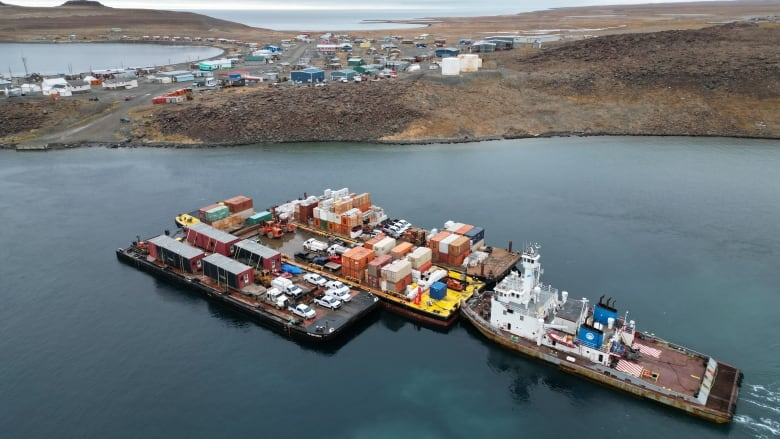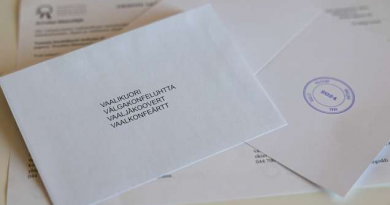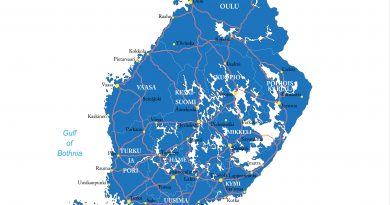N.W.T. gov’t to help cover shipping costs to communities after barge cancellations

Ongoing issues show why Mackenzie Valley Highway is needed, says minister
The N.W.T. government has introduced a new funding program aimed at helping offset the costs of what the territory’s industry minister is calling “an extraordinary event”: the lack of barge resupply to the N.W.T.’s Sahtu and Beaufort Delta regions this summer.
Barge cancellations earlier this year — due to historic low water levels on the Mackenzie River — have forced communities to fly in supplies and led to staggering price increases. The situation has been characterized as a “crisis” and “chaos.”
According to Caitlin Cleveland, the territory’s minister of industry, tourism and investment, it’s caused “a sudden and severe interruption in a critical supply route to a region that has no other supply alternatives.”
Under the new one-time funding program, community and Indigenous governments, as well as businesses, are eligible to recoup up to 50 per cent of the difference in costs between barging versus flying supplies in, up to a maximum of $30,000 per business. The program has a total fund of $1.8 million.
Eligible goods under the program include: food, home heating fuel, medical supplies and construction materials.
“Our anticipation of course is that we’ll continue to monitor the water levels along the Mackenzie and do our best to continue barging up the Mackenzie River,” said Cleveland.
The deadline to apply to the program is March 7, 2025.
Some communities can’t wait for winter roads
Cleveland acknowledged the Sahtu has the highest cost-of-living in the territory.
“Many of the communities will be able to make it through until the winter roads start up, but others in the Sahtu and the Beaufort Delta will likely be compromised and unable to wait for the winter road system to become operational,” she said.

According to the Department of Infrastructure’s web page, opening dates for winter roads to Sahtu communities are typically between Dec. 20 to Jan. 14.
In a news release announcing the new funding program, the territory said it would be bringing in some changes to this winter’s Mackenzie Valley Winter Road to deal with a higher amount of traffic as communities resupply.
The changes include widening sections where possible, bringing in additional signage, and additional patrols and checkpoints along the route.
Low water levels likely to stick around
In the Wednesday news release, the N.W.T. government said water levels near Norman Wells have dropped by about four metres since June 2022.
Emma Riley, a government hydrologist, said those levels are unlikely to return to normal by next spring.
“We do really need record-high snowpack or greater than average snowpack in order to start to recover from low water levels,” she said. “But because we’re sort of outside of the range of what is considered normal … it’s very hard for us to know exactly how much snow is needed throughout the winter in order to get to average levels.”
She linked the extreme variability in the territory’s water levels in the last few yeast to climate change, adding it is “something we can expect to continue to see within our systems.”
Mackenzie Valley Highway at least decade away
This is the second consecutive year the low water levels have affected the territory’s barge season.
“The Mackenzie Valley Highway obviously would provide a permanent solution to the issues we’re facing right now,” said Lorne Brown, the territory’s director of fuel services. “And had it been in place years ago, we wouldn’t be having this conversation right now.”
Cleveland is among a delegation of N.W.T. leaders this week in Ottawa to meet with federal ministers. Part of that is calling for more federal support for the highway.
“We see the need of being able to work on this project in an accelerated timeline,” said Cleveland.
But, according to the territorial government’s own estimate, the proposed portion of the Mackenzie Valley Highway from Wrigley to Norman Wells is going to take 10 years to build, and construction can only begin once the current environmental assessment process finishes.
In the meantime, Cleveland said the government will continue to monitor the needs in the region in coming years and respond appropriately.
“We need to be able to be fluid,” she said. “And so having a support program that is stagnant, that doesn’t respond to where we’re actually at in the Northwest Territories and what communities are dealing with, doesn’t really help us really address the situation.”
In its announcement, the territory also said it would continue to pay the heating costs for income assistance clients and that it was “prepared to increase financial supports” for its home-heating subsidy for seniors.
Related stories from around the North:
Canada: N.W.T. leaders present unified front in meetings with federal government, CBC News
Russia: Putin in Arkhangelsk: Arctic industry and infrastructure on agenda, The Independent Barents Observer
United States: U.S. Navy to build airport infrastructure in North Norway to meet upped Russian submarine presence, The Independent Barents Observer



